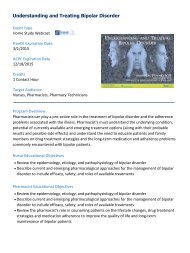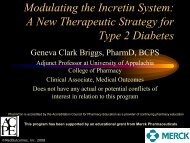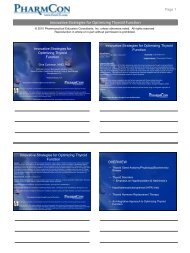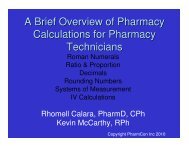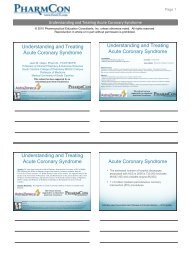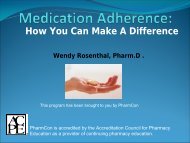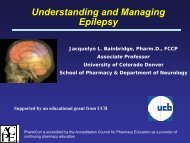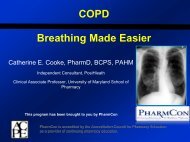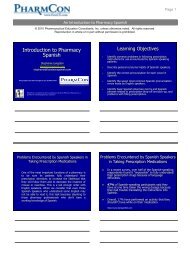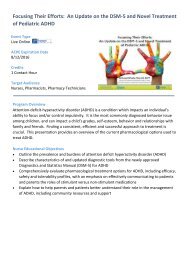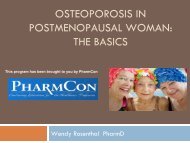Bipolar Disorder - Free CE Continuing Education online pharmacy ...
Bipolar Disorder - Free CE Continuing Education online pharmacy ...
Bipolar Disorder - Free CE Continuing Education online pharmacy ...
You also want an ePaper? Increase the reach of your titles
YUMPU automatically turns print PDFs into web optimized ePapers that Google loves.
The Case of Nikki• 8 years old• Adopted• Biological mother: bipolar, substanceabuse• Hyperactive, impulsive, very attentive• Aggressive, irritable, assaultive,periods of grandiosity• Episodes of psychosis
Epidemiology• <strong>Bipolar</strong> I: 0.4-1.6%,M=F (All forms: 2.6%)• <strong>Bipolar</strong> II: 0.5%, F>M• May be as high as 1%in youths• Early onset M>F• Across cultures, races• Age of onset: 21 years• Males manic first• Females depressedfirst
Epidemiology• 2/3 affected have closefamily member affected• One parent: risk is 15-30%• Two parents: risk is 50-75%• Sibling: risk is 15-25%• Identical twin: risk is 70%
Cost of <strong>Bipolar</strong> <strong>Disorder</strong>s• $45 billion annually: direct and indirectcosts• <strong>Bipolar</strong> pt/yr: $3415• Diabetes pt/yr: $2570• General medical outpatient/yr: $1462• Unemployment rate: up to 60%• 6 th leading cause of disability in world• Delay in diagnosis increases costs
What is Classic <strong>Bipolar</strong>?• “Manic Depression”• <strong>Bipolar</strong> is both ends of the spectrum• Severe mood swings• Classic form: periods of extreme depressionto periods of exaggerated happiness oreuphoria or irritability• Many shades of the illness in between theextremes• Episodic nature, chronic, variable course
What are the forms ofbipolar disorder?• <strong>Bipolar</strong> I <strong>Disorder</strong>• <strong>Bipolar</strong> II <strong>Disorder</strong>• <strong>Bipolar</strong> <strong>Disorder</strong> NOS• Cyclothymic <strong>Disorder</strong>• Mood <strong>Disorder</strong> Due to GeneralMedical Condition• Substance-Induced Mood <strong>Disorder</strong>• Multiple Specifiers For Most Types
DSM Criteria for <strong>Bipolar</strong> ID.O.• Must have or had at least one episodeof mania• Some patients have had or will have amajor depression• Episodes can be depressive, manic ormixed
What is <strong>Bipolar</strong> II D.O.?• Must have or had one or moreepisodes of MDD• Must have or had at least one episodeof hypomania• Never had a manic episode
What is Cyclothymic<strong>Disorder</strong>?• 2 years minimum (1 year in children)• Numerous periods of hypomania• Numerous periods of depression butnot MDD
What is Mania?• Period of abnormally elevated, expansive or irritablemood• Lasts at least one week or less if hospitalized• Inflated self esteem, grandiosity• Decreased need for sleep• More talkative, pressured speech• Flight of ideas, racing thoughts• Distractibility• Increased goal-directed activity or psychomotoragitation• Increased pleasure seeking with high potential fornegative consequences
What is Hypomania?• Like mania, just less severe• Period of elevated, expansive orirritable mood• At least 4 days• Not severe enough to cause markedimpairment or require hospitalization,no psychotic features
What is a MajorDepressive Event?• Depressed mood (irritable in children) andSIG-E-CAPS criteria• S: suicidal ideation• I: : decreased interests• G: : excessive guilt (worthlessness,hopelessness)• E: : decreased energy• C: : decreased concentration• A: appetite• P: psychomotor retardation or agitation• S: sleep disturbance
<strong>Bipolar</strong> Depression• Earlier onset < 25 y. o.• 5 or more spells of MDD• Family hx of bipolar• Atypical depressive symptoms• Psychotic features• Brief, frequent episodes of depression• Complex comorbidity• Mixed episodes• History of antidepressant induced mania/hypomania
<strong>Bipolar</strong> <strong>Disorder</strong> andPsychosis• Psychosis may be part of mania ordepression• Catatonia• Mania in adolescents: psychosiscommon, grandiose delusions
Task ForceRecommendations• International team of experts• Expanding diagnostic criteria for severalsubtypes• Add pediatric category• <strong>Bipolar</strong> II: not “soft bipolar”• Add ultra-rapid rapid cycling specifier• Not over diagnosed• A spectrum disorder• Use of diagnostic tools increase accuracy ofdiagnosis
Pediatric Variant of<strong>Bipolar</strong> <strong>Disorder</strong>• Broad phenotype• Most often don’t t display classic mania• Broad or narrow application ofcriteria???• No pathognomonic clincher fordiagnosis• Is there another dx: Severe MoodDysregulation?
Pediatric <strong>Bipolar</strong> =<strong>Bipolar</strong> N.O.S.?• Predominant mood is highly irritable• Aggressive• Mood swings• Rapid cycling of mood (ultradian)• Recurrent & chronic (low inter-episodicepisodic recovery)• Mixed mood symptoms• Comorbid psychiatric disorders• Family history of bipolar disorder
What does mania looklike in children?• Poor sleep but energetic during day• Goal-directed activities: coloring, drawingwith bright colors, building, writing, making“big” plans• Hypersexuality: pleasure-seeking, seeking, notanxious, compulsive• Melt-downs over trivial items• Poor boundaries, taking charge, little regardfor authority
Diagnostic Conundrum• Many youth withexplosive,dysregulated moodsand emotionallability• Are they all bipolar?• Is this the samebipolar as seen inadults?
Controversy Continues• NIMH round-table: children can be diagnosed with bipolardisorder• <strong>Bipolar</strong> disorder Not Otherwise Specified – best workingdiagnosis• Current treatment is based on adult literature.• Need more research in children• Serious treatment implications• Later adolescence dx = bipolar dx age 24• <strong>Bipolar</strong> NOS dx in younger children=psychopathology, adverseoutcomes in young adults• <strong>Bipolar</strong> NOS dx younger children = bipolar dx in young adults
Controversy Continues28%35%>18 yr
Course of Disease inAdults• First episode may be mania, hypomania,depressive or mixed.• First episode may be followed by symptom-free years• Associated with substance abuse,recklessness, impulsivity, antisocial behavior• Variability is hallmark of illness• Chronic illness• No cure• Very treatable• Suicide completion rate is high: 10-15%15%(M>F)
Course of Disease inChildren and Adolescents• Not one episode• Symptoms ever present, fluctuating• Limited periods of euthymia• No clear pattern of cycling• Diagnosis often changes in adult• Severe comorbidity
Differential Diagnosis:Medical Conditions• Neoplasms• Epilepsy• Multiple Sclerosis• Trauma• Endocrine: thyroid,pheochromocytoma• Substance-induced• Lupus• Medication-induced:induced:steroids• Infection: HIV• Wilson’s s Disease
Comorbid Conditions• ADHD• Anxiety disorders: OCD and Panic<strong>Disorder</strong>• Conduct DO/ODD• Substance abuse
<strong>Bipolar</strong> <strong>Disorder</strong> : 1° 1• ADHD: up to 90%• Anxiety <strong>Disorder</strong>s: 51%• Conduct <strong>Disorder</strong>: 41-74%• Substance Abuse: 60%
Other <strong>Disorder</strong>s 1° 1• ADHD: 23% had bipolar• Panic <strong>Disorder</strong>: 12-23% 23% had bipolar• Conduct <strong>Disorder</strong>: 40% had bipolar• Substance Abuse: 40% had bipolar
Diagnostic Work-up• Clinical diagnosis: history andinterview• Screening rating scales: Young ManiaRating Scale, CBCL• Labs: CMP, TSH, LFTs, U/A,toxicology screen, lead (
Neuroimaging Findings• Nonspecific and variable• Some studies: increased gray matterin left temporal, decrease gray matterin anterior cingulate gyrus bilaterally• Ventricular enlargement• Not diagnostic• More research needed
Suicide Risk with <strong>Bipolar</strong><strong>Disorder</strong>• 25-50% 50% attempt suicide• 10-15% 15% complete suicideHigher with:• Mixed episode• Psychosis• History of hospitalization• History of self-injurious behavior• Comorbid panic disorder• Comorbid substance abuse
Treatment ApproachesAcute phase:• Hospitalization: secure patient• Day treatment• Medication a must• <strong>Education</strong>: patient and family• Psychotherapy & family therapy• Mood charting• Sleep hygiene
Treatment ApproachesPreventative/maintenance phase:• Noncompliance is common• Two or more episodesmania/depression=life long medication• Maintain regular sleep and daily patterns• Do not use drugs/alcohol• Reduce stress• Recognize early warning signs• Don’t t abruptly stop meds-talk to your doctor• Enlist support of family/friends
Treatment Goals• Assess and treat acute exacerbations• Decrease distress• Improve functioning between episodes• Prevent recurrences• Provide support and insight to patientand family• HOPE!
Specific Therapies• FFT: Functional Family Therapy• Triggers and day to day changes• Understanding diagnosis & need formed compliance• Preventative Measures• Sleep/waking cycle importance• Address mood issues in familymembers
Now, let’s s get to the meds• Lithium: antimanic effects discoveredin 1949, used extensively since 1960’s• Anticonvulsants: effects discovered in1970’s• Antipsychotics: atypicals and typicals
Lithium (Eskalith,Lithobid)• Generic available• 900-2400 mg/day• QD or BID• Check serum levels:0.6-1.5 mEq/L• Check serum levels:Day 3-4, 31 mos, 3-63mos, dose change• Labs: CBC, renal,lytes, U/A, TSH,pregnancy test, ECG
Lithium (Eskalith,Lithobid)Side effects:• Acne• Renal dysfunction• Cognition• Diarrhea, GI distress• Hypothyroidism• Polyuria, polydipsia• Tremor• Weight gain• SedationDrug interactions:• A<strong>CE</strong> inhibitors• Diuretics• NSAIDs• Theophylline• Caffeine
Valproate (Depakote)• 750-2000mg/day• Q hs or BID• Labs: LFTs, CBC, Cr,BUN, pregnancy test• Check serum levels:50-150mcg/ml• Check serum levels: 1-12 weeks, then 3-63months, dosagechange
Valproate (Depakote)Side effects:• Alopecia• Ataxia, tremor• Cognitive impairment• Dizziness• GI upset• Liver and plateletdysfunction• PCOS• Weight gain• Sedation• RashDrug interactions:• Antipsychotics• Benzodiazepines• Carbamazepine• Lamotrigine• Lithium• MAOIs• Phenytoin• TCAs• Warfarin
Carbamazepine (Tegretol)• Generic available• 400-1600mg/day• BID or TID• Labs: CBC, LFTs,pregnancy test, lytes• Check serum levels: 4-412 mcg/ml• Check serum levels:day 5-7, 5weekly ‘tilstable, 3-636 months
Carbamazepine (Tegretol)Side effects:• Ataxia• Diplopia, nystagmus• Dizziness• Dysarthria• GI upset• Hyponatremia• Leukopenia• Rash• SedationDrug interactions:• Induces ownmetabolism• Antipsychotics• Benzodiazepines• Cimetidine• Corticosteroids• Valproate• Erythromycin• Lamotrigine• OCP• TCA• Warfarin
Lamotrigine• Generic available• 200mg/day• Titrate slowly• QD or BID• Labs: renal, LFTs,pregnancy test
LamotrigineSide effects:• Ataxia• Dizziness• Headache• Nausea• Serious rash-Stevens JohnsonSyndrome• SedationDrug interactions:• Carbamazepine• Valproate
Recent Advisory for MoodStabilizers• All current antiepileptics pose increaserisk of suicidality• Patients/parents should be warned• No black box advisory• Included carbamazepine,oxcarbazepine, valproate amongothers
Risperidone (Risperdal)• 1993• 1-8mg daily• Only depot form of atypical• Depot form q 2 weeks• Weight gain, sedation and high prolactinmost common• Above 6 mg daily- EPS
Olanzapine (Zyprexa)• 5-20mg daily• Very sedating• Excessive weight gain• Metabolic syndrome
Quetiapine (Seroquel)• 300-800 mg daily• Moderate for weight gain• Slit lamp eye exam recommended-cataracts, not often done• Very sedating
Ziprasidone (Geodon)• 40-160mg daily• 2001• Short acting injectable available• Can be used for acute agitation• More weight neutral than otheratypicals• Lower incidence of metabolicsyndrome
Aripiprazole (Abilify)• 10-30mg daily• “Dopamine stabilizer”• Agonist in areas of low activity• More weight neutral• Low incidence of metabolic syndrome
Clozapine (Clozaril)• 25-900mg daily• 1989• Weight gain• Agranulocytosis- serious, fatal• Weekly WBC count• Specific protocol-complex complex to manage• Used in refractory cases• Seizures• Excessive salivation
FDA Approved Medicationsfor Pediatric <strong>Bipolar</strong><strong>Disorder</strong>• Lithium: ages 12-17 17 yo• Risperidone, Aripiprazole: ages 10-17 yo• Panel recommended approval ofQuetiapine, Ziprasidone, Olanzapine
Treatment AlgorithmPediatric Mania/MixedPsychosisNoresponseLi, VPA or CBZOr SGAnoSome responseyesLi or VPA or CBZ+SGASwitch(monotherapy)Li+VPA orLi+ SGA orVPA+ SGASome responseLi+VPA+SGAOr Li+CBZ+SGASome responseLi+VPA+SGA orLi+CBZ+SGAKowatch, RA, et al, J.Am.Acad.Child.Adol.Psych, 44(3):213-223, 2005SGA: Olanzapine, Risperidone, QuetiapineVPA: Valproic AcidCBZ: CarbamazepineLi: Lithium
Treatment Algorithm:Depressive Symptoms• Add lithium, buproprion or SSRI tomood stabilizer• Consider lamotrigine
Treating Comorbidity• Stabilize mood (manic, mixedsymptoms) first• Treat ADHD symptoms ( watchstimulants closely, ??atomoxetine)• Treat anxiety• Watch for activation
Long term Maintenance• Use what works• 1-2 years stable, , then consider carefultaper• Don’t t let children cycle withoutintervention
<strong>Bipolar</strong> Knows NoBoundaries• Kurt Cobain• Jane Pauley• Patty Duke• Ted Turner• Sinead O’ConnorO• Winston Churchill• Handel• Keats• Dickens
References• Diagnostic and Statistical Manual of Mental <strong>Disorder</strong>s, fourth edition, Text Revision,American Psychiatric Association, 2000• Physicians Desk Reference, 2008• Konstantinos N et al; Treatment of <strong>Bipolar</strong> <strong>Disorder</strong>: A Complex Treatment Tfor a Multi-Faceted <strong>Disorder</strong>; Annals of General Psychiatry, , 2007, 6:27• Ghaemi, SN, Bauer M, Cassidy F, et al; ISBD Diagnostic Guidelines s Task Force.Diagnostic Guidelines for <strong>Bipolar</strong> <strong>Disorder</strong>: A Summary of the International Society for<strong>Bipolar</strong> <strong>Disorder</strong>s Diagnostic Guidelines Task Force Report. <strong>Bipolar</strong> Disord. . 2008;10(1, pt2):117-128.128.• NIMH, Questions and Answers about the NIMH Clinical Antipsychotic c Trials ofIntervention Effectiveness Study (CATIE),http://www.nimh.gov/healthinformation.catieqa.cfm• Practice Guidelines for the Treatment of Patients with <strong>Bipolar</strong> <strong>Disorder</strong>, DSecond Edition,2002, American Psychiatric Association• Pandey, G. et al, “Brain-derived Neutrophic Factor Gene Expression in Pediatric <strong>Bipolar</strong><strong>Disorder</strong>: Effects of Treatment and Clinical Response,”J.Am.Acad.Child.Adolesc.Psychiatry, , 47:9, 1077-1085, 1085, Sept. 2008• Weller, E. et al, “<strong>Bipolar</strong> <strong>Disorder</strong> in Children and Adolescents: Diagnosis andTreatment,” Current Opinion in Psychiatry, , 16(4), 2003.• West, S., “Adolescent Mania and <strong>Bipolar</strong> <strong>Disorder</strong>,” Medscape Psychiatry and MentalHealth eJournal, 2(5), 1997
References• Kahn, D., Ross, R., Printz, D., Sachs G., Treatment of <strong>Bipolar</strong> <strong>Disorder</strong>: DA Guide forPatients and Families; Medication Treatment of <strong>Bipolar</strong> <strong>Disorder</strong> 2000, Expert ConsensusGuideline Series• Ghaemi, S. N., “Defining the Boundaries of Childhood <strong>Bipolar</strong> <strong>Disorder</strong>,” Am.J.Psychiatry,164:185-188k 188k Feb 2007• Levin, A., “Researchers Refine Criteria for Childhood <strong>Bipolar</strong> <strong>Disorder</strong>,” Psychiatric News,Vol 44, Number 1,p. 17, Jan. 2,2009• Schapiro, N., “<strong>Bipolar</strong> <strong>Disorder</strong>s in Children and Adolescents,” J. of Pediatric Health Care,19 (3): 131-141, 141, 2005• Weller, E. et al, “<strong>Bipolar</strong> <strong>Disorder</strong> in Children: Misdiagnosis, Underdiagnosis, and FutureDirections,” J.Am.Acad.Child.Adolesc.Psychiatry, , 34:6, 709-714, 714, June, 1995• Karantaris, V., “Treatment of <strong>Bipolar</strong> <strong>Disorder</strong> in Children and Adolescents,”J.Am.Acad.Child.Adolesc.Psychiatry, , 34:6, 732-741, 741, June, 1995.• Akiskal, H., “Developmental Pathways to <strong>Bipolar</strong>ity: Are Juvenile-Onset Depressions Pre-<strong>Bipolar</strong>,” J.Am.Acad.Child.Adolesc.Psychiatry, , 34:6, 754-763, 763, June, 1995.• Biederman, J., “Developmental Subtypes of Juvenile <strong>Bipolar</strong> <strong>Disorder</strong>,” Harvard Rev.Psychiatry, , 3: 227-230, 230, 1995• American Academy of Adolescent and Child Psychiatry, “Practice Parameter for theAssessment and Treatment of Children and Adolescents with <strong>Bipolar</strong> r <strong>Disorder</strong>, “J.Am.Acad.Child.Adolesc.Psychiatry, , 46:1,107-125, 125, January, 2007.



